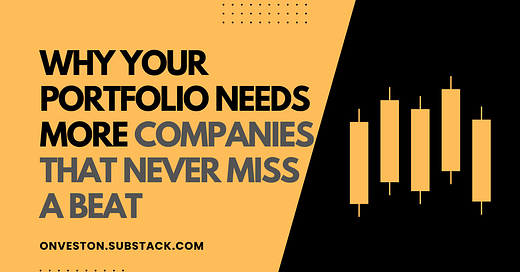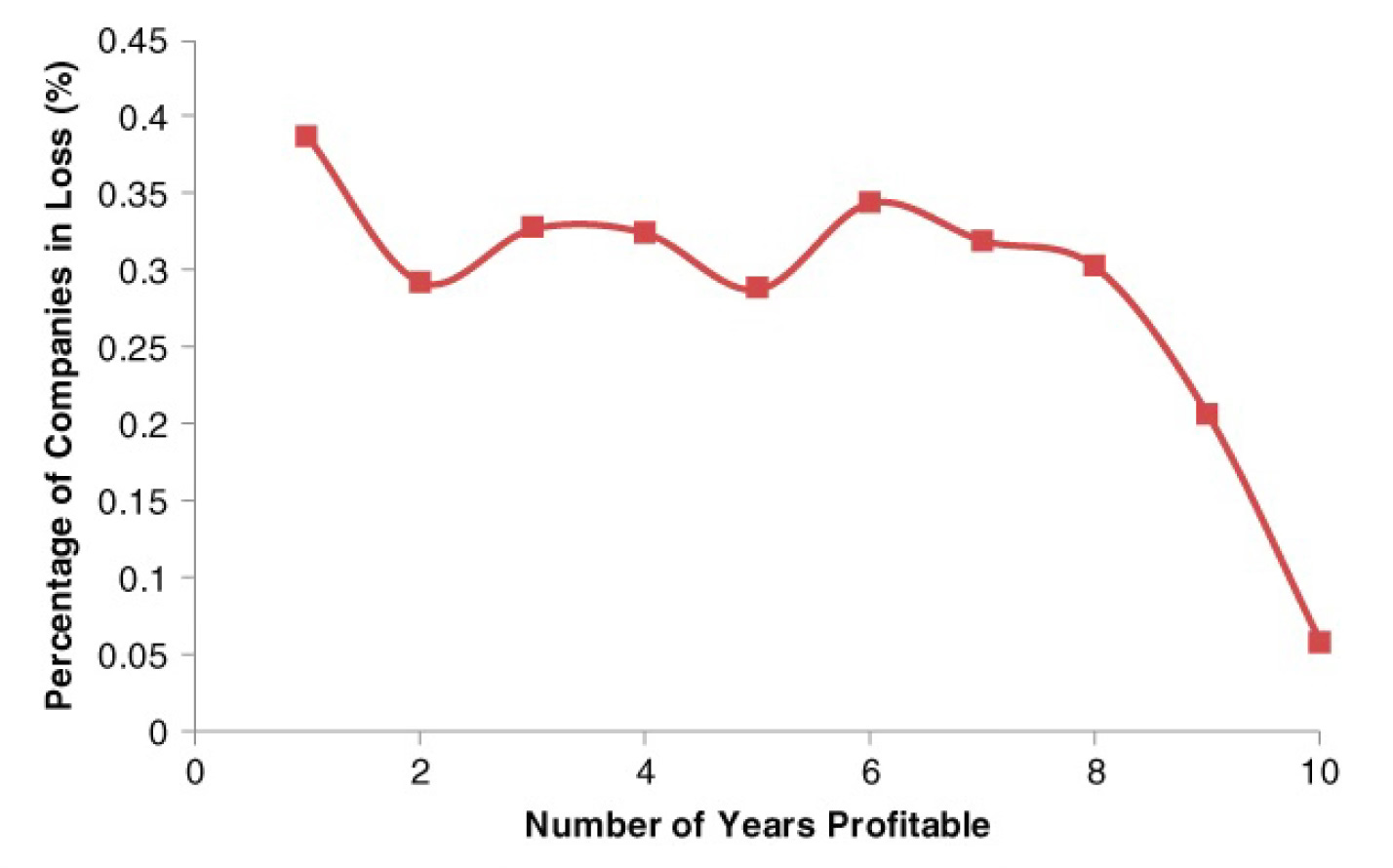Why Your Portfolio Needs More Companies That Never Miss A Beat
Profitability + Consistency Is Key When Selecting Stocks
Dear investor,
I hope this message finds you well.
I keep hearing people say "you can't predict the future of a stock" - even from experienced investors who should know better.
But this completely misses the point of stock picking.
You don't need to predict anything.
You just need a solid framework for spotting potential winners.
Any good framework looks at the past because that's where your data comes from. You're checking how stocks performed when they met certain criteria.
You can't connect the dots looking forward; you can only connect them looking backward.
That's why you should stick with time-tested strategies instead of analyst forecasts.
One simple thing to look for is consistency plus profitability.
This tells you a lot about the company's niche and how well management runs the business.
Always pick profitable companies over unprofitable ones that “might become profitable someday”.
And pick companies that make money year after year over those with inconsistent profits.
This sounds obvious, but most people ignore this basic framework.
Let me show you some numbers to prove how big the difference is between consistent performers and the occasional winners.
The data is from the book “Invest Like A Guru” by Charlie Tian (good book btw).
The data is a bit old, but the rules still stand.
The author has performed a calculation for all the U.S. companies that have been traded in the U.S. market from 2006 until 2015.
The results are represented in the table below:
From 2006 until 2015, 3,577 companies have been trading continuously on the stock market.
Out of those, only 1,045 companies - about 29% - made money every single year.
Those consistently profitable companies did really well.
They averaged 8.5% gains per year, which is double what the second-best group earned.
That second group made money in nine out of ten years but only averaged 4.2% annual gains.
Here's where it gets interesting: companies that were profitable six years or fewer actually lost money overall, even if you held them for the full ten years.
We see a clear trend as shown in the graph below:
The risk of losing money drops dramatically when you pick consistently profitable companies.
The always-profitable companies had only a 6% chance of losing investors' money, while companies profitable in nine out of ten years had a 21% chance of losses.
Now, you might wonder if this study is biased because it only looks at companies that survived the full ten years.
Yes, it is, but the study is also biased toward companies that struggled.
Why?
Because all the companies that kept losing money and went bankrupt aren't included in these numbers. If they were, the money-losing companies would look even worse, and the percentage of companies that lost money would be much higher.
Final Thoughts
If you only bought stocks from companies that always turn a profit, you'd likely avoid losses and beat the market.
But there’s a catch - we can't see into the future.
Just because a company has been profitable doesn't guarantee it'll stay that way.
That's why you should focus on companies with consistently high profit margins.
When a business can keep its profit margins above average year after year, it usually means they have something special protecting them from competitors - maybe a strong brand, unique technology, or market position that lets them charge premium prices.
Think of it like this: companies with fat profit margins have a cushion.
When tough times hit, they can absorb the blow and still make money.
But companies running on thin margins? They're walking a tightrope.
One bad quarter and they're suddenly losing money, which typically hammers their stock price.
It's the difference between a business that's built to last and one that's just getting by.
The companies with room to breathe tend to weather storms much better than those living paycheck to paycheck.
Stick to the rules and remember: Time is a friend of the good business and an enemy of the mediocre.
Until the next issue.
☕ Enjoying these insights? If my articles help you make smarter investments, consider buying me a coffee. It’s a small way to support the work and keep these ideas coming. 👉 Buy me a coffee 👈
Premium Content 📈
I buy individual stocks for my own portfolio and I analyze individual stocks for my clients.
Elite companies with elite management and unique products are the ones that perform the best - all you have to do is give them some time.
Every few weeks, I introduce a handpicked stock that stands out for its strong fundamentals, competitive moat, and growth potential.
Backed by in-depth analysis, each recommendation is carefully chosen to help you build wealth sustainably over time.
Don’t just follow the market - get ahead of it with strategies tailored for serious, patient investors who seek consistent, long-term success.
Start building a portfolio of elite businesses step by step - while Wall Street lemmings follow the crowd.
If this resonates with you, then get the last 4 reports today and gain the edge you need during uncertain times.
👉 Start Investing In Elite Businesses 👈
If you enjoy The Onveston Letter, let me and the algorithm know by clicking the “Like” button ❤️.
And if you aren’t a subscriber yet, then sign up below to not miss out on future articles.
For new readers: Check out all my previous posts here
Disclaimer: This analysis is not advice to buy or sell this or any stock; it is just pointing out an objective observation of unique patterns that developed from my research. Nothing herein should be construed as an offer to buy or sell securities or to give individual investment advice.







